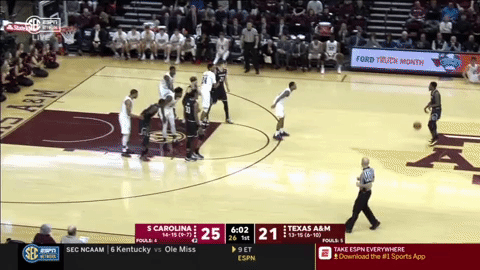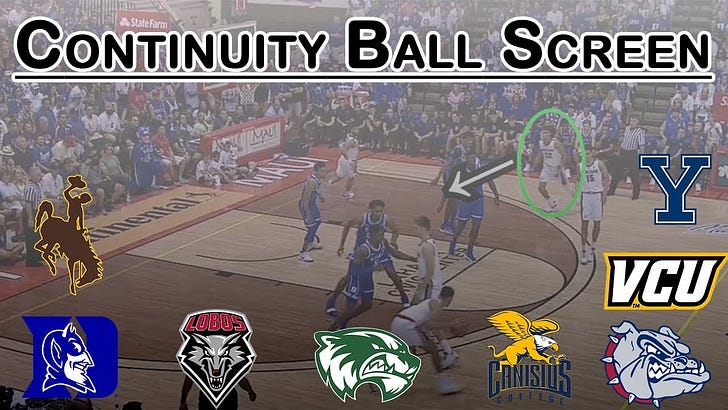The return of Solving Basketball
Welcome back to the Hoop Vision Weekly — and welcome back to the Solving Basketball podcast!
This week, we kicked off the second season of Solving Basketball with Duke associate head coach Jon Scheyer. We talked about:
Free throws out of 100: Jon is the most prolific Solving Basketball guest free throw shooter yet
Duke’s X’s and O’s: How the system has involved from Jon’s playing days to now
Duke’s historically strong three-point defense
The scouting decision to be the first team to switch everything against Virginia’s Blocker-Mover offense
The use of analytics for both coaches and players
Solving Basketball is available on all podcasting apps; click/tap for the YouTube and Apple podcasts versions.
In this week’s newsletter we discuss:
How ideas spread in the coaching world
The most-run plays at the college level
What might be next on the X’s and O’s horizon
The most-run plays in college basketball
Both directly and indirectly, we have covered a lot of the most common offensive and defensive schemes in college basketball over the last year at Hoop Vision.
It started with a 12-minute video on continuity ball screen…
The play has European roots, but Canisius head coach Reggie Witherspoon is considered the college basketball “godfather” of the offense.
In my opinion, continuity ball screen is the modern day parallel to the Flex offense. Similar to the Flex, it can be implemented both on a very superficial or more sophisticated level.
Some teams use continuity ball screen simply as a change-of-pace offense to get the ball and the opponent moving. Other teams use it as a primary offense and invest practice time into several different wrinkles and counters; in general, it has a flexible enough framework to function in different ways.
Another example of this — which you’ll see from seemingly every team in the country at some point — is “Zone America.”
So why (and how) does a play spread like wildfire around the country?
With the internet serving as a basketball community for thousands of coaches, it doesn’t take very long. But there are a couple more specific reasons basketball becomes a copycat sport.
1) If you can’t stop it, adopt it
With the amount of scouting done for an individual opponent at the college level, copycats are inevitable. In general, the best way to test the usefulness of a play or concept is by gameplanning a way to stop it.
Back on August 11th in this space, we detailed Bill Self’s post pin offense. That newsletter contained GIFs and screenshots of Self’s bread-and-butter set; here’s that same set, but run by a different team:

That is Frank Martin’s South Carolina team faking the reversal to throw back for the famous Self-style post pin. Frank Martin was, of course, the head coach of Kansas State for five seasons — where he coached against Bill Self 11 times.
If a play has worked against you, it might make sense to steal it. And coaches will often times even name it after the team they stole from.
2) The most successful = the most susceptible
Understandably, nothing captures the attention of the basketball community quite like a winner.
When Gregg Popovich, Tim Duncan, and the Spurs were winning their titles, coaches all around the country were adopting motion weak, motion strong, and loop.
Similarly, the Warriors have been emulated by other teams around the country. Maybe most notably, their split cuts on post entries — which dates back to the adoption of the Princeton offense — have had a resurgence at the college level.
If continuity ball screen wasn’t popular enough already, Virginia installing the offense and then going ahead and winning a national championship certainly won’t diminish the trend.
The story behind Dribble Drive Motion
There’s an excellent article from 2008 by Sports Illustrated’s Grant Wahl on the rise of the Dribble Drive Motion offense.
The offense was created by a high school and junior college coach named Vance Walberg; he called it AASAA, an acronym for “Attack-Attack-Skip-Attack-Attack”.
John Calipari would be the coach to eventually brand it as “Dribble Drive Motion”.
The offense was innovative for a variety of reasons. First and foremost, the dribble drive was the primary way scoring opportunities were created. That idea was much different than the Bob Knight-style motion offense using off-ball screens, or the Pete Carril-style Princeton offense using off-ball cuts.
Another key change in Walberg’s offense was moving his big man from the strong side over to the weak side, for better spacing and lob opportunities.
Wahl’s 2008 article talks about those changes, but also how the offense quickly swept the entire country with coaches looking for more information.
Larry Brown eventually became interested in the offense, but not before telling Calipari:
"You've won hundreds of games playing a certain way, and now you're going to change? And it's a junior college coach from California? What are you, crazy?"
Legendary high school coach Bob Hurley began using the offense without having any contact with Walberg:
"I've had very few original thoughts in my life, but I'm smart enough to take from people who are successful and seem to have a greater view of the game.”
But of all of the topics and quotes in the article, this one stands out to me as the most insightful:
In fact, some coaches think Walberg's drills are his crowning achievement.
"It's like a franchise for McDonald's," says [Nuggets assistant coach John] Welch. "Not only are you getting a system, you're getting built-in drills to teach your system."
More on that in the next section…
The pitfalls — and future — of copying
The coaches who were installing Dribble Drive Motion all raved about Walberg’s drills and practices…and that’s precisely what can get lost in the process of copying.
The Spurs’ offense mentioned earlier is one of the best examples of this idea. Thanks to a wildly successful decade by Gregg Popovich, teams all over the country installed motion strong, motion weak, and loop.
Those three plays, while undeniably effective for the Spurs, are almost hilariously simple at face value. Motion strong is a stagger screen away. Motion weak is a screen-the-screener. Loop is three players screening for a baseline a runner.
The actions themselves are hardly special. It was the execution of those actions — player movement, ball movement, reading the defense, and unselfishness — that made the Spurs historically elite.
Simply copying plays, no matter how successful the play — without copying the associated practice planning and teaching — is relatively pointless.
So what’s next on the horizon for coach copying?
With ball screen usage continuing to increase at the highest levels of basketball, a lot of the innovation (and copying) has been built upon the idea of interfering with the most important defenders in a ball screen coverage.
It would be very hard to watch a college basketball game without seeing one of the following ball screen concepts:
Spain — screening the defender guarding the ball screener as or after the ball screen is occurring
Wedge — screening the defender guarding the ball screener before the ball screen occurs
Chin — having the ball screener set a backscreen before setting the eventual ball screen
Ball screen creativity should only continue to rise next season and moving forward; Villanova’s run of two national titles in three years certainly did a lot for the spread and three-point heavy style of offense.
And finally, I would not be surprised — for better or for worse — to see Chris Beard’s big success with no-middle defense have some influence around the country. Other teams teach keeping the ball out of the middle, but Texas Tech’s extreme commitment to doing so is currently unparalleled.
ICYMI earlier this week
UNC Greensboro and Wes Miller got the breakdown treatment over on Twitter this week. Some videos on:
Motion strong (notice how the reads — not the action — are the most important part)
Wheel, wheel to slice, wheel to (fake slice) pin, wheel to (fake slice) stagger
And here’s a bonus, newsletter-exclusive video on UNC Greensboro’s chin action that compliments the wheel action already tweeted out.
Graphs this week included:


